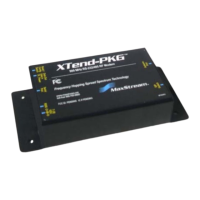9XTend-PKG-U™ USB RF Modem User’s Guide
45
4.2.2. Multi-Transmit Mode
Attributes:Reliable Delivery through forced transmission of every RF packet
Every RF packet is sent exactly (MT + 1) times with no delays between packets
Diminished throughput and increased latency
Required Parameter Values (TX modem): MT (Multi-Transmit) >= 1
Other Related Commands: Networking (DT, MK, MY, RN, TT), Serial Interfacing (BR, PK, RB,
RO), RF Interfacing (FS)
Recommended Use: Use for applications that require Reliable Delivery without using retries and
acknowledgements.
Connection Sequence
Figure 4-05. Multi-Transmit Mode State Diagram
(TX Module)
In Multi-Transmit Mode, each packet is
retransmitted MT times, for a total of (MT+1)
transmissions. There is no delay between
retransmissions, and the TX (transmitting)
modem will never receive RF data between
retransmissions. Each retransmission includes
an RF initializer. A transmission event may
include follow-on packets, each of which will be
retransmitted MT times. The Forced Sync (FS)
parameter is ignored in Multi-Transmit Mode.
The RB and RO parameters are not applied to
follow-on packets, meaning that once trans-
mission has begun, it will continue uninter-
rupted until the DI buffer is empty or the
streaming limit (TT parameter) has been
reached. As with the first packet, the payload
of each follow-on packet includes up to the
maximum packet size (PK parameter) bytes,
and the TX modem checks for more pending
data near the end of each packet. Follow-on
packets are not sent until all retransmissions of
the previous packet are finished.
The streaming limit (TT) is specified at the TX
modem as the maximum number of bytes that
the TX modem can send in one transmission
event, which may consist of many packets. If
the TT parameter is reached, the TX modem
will force a random delay of 1 to RN delay slots
(exactly 1 delay slot if RN is zero). In Multi-
Transmit Mode, each packet is counted only
once when tracking the streaming limit (TT),
no matter how many times it is retransmitted.
When an RX (receiving) module receives a
Multi-Transmit packet, it calculates the amount
of time remaining in the Multi-Transmit event,
and inhibits its own transmissions for the dura-
tion of the Multi-Transmit event, plus a random
number of delay slots between 0 and (RN-1). If the local RN parameter is zero, the delay is only
for the calculated duration of the Multi-Transmit event. Thus, an RX modem need only receive one
of the transmissions, and it will keep off the channel until the TX modem is done. If follow-on
packets are coming, the RX modems will move to the new frequency and listen for the follow-on
packet for a specific period of time.

